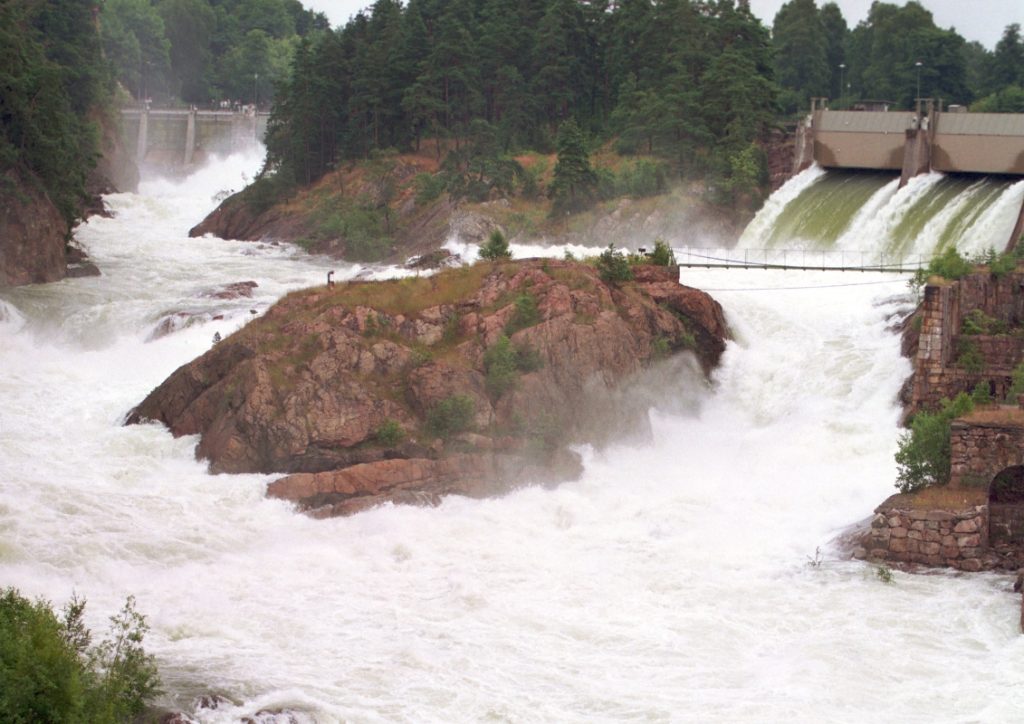Denna historia faller ju lite utanför ramen för Bohuslän, men bara med några meter, för Göta älv utgör ju gränsen mellan Bohuslän och Västergötland.
I 40 år var jag anställd för drift och underhåll av Olidans kraftstation och ytterligare tre anläggningar i Göta älv. Är numera pensionär , men anläggningarna kommer troligtvis inte märka av detta faktum utan tack vare att dom är byggda med yppersta kvalite leverera el i många år framöver.
Kraftverket Olidan var svenska statens första vattenkraftprojekt. Staten hade under lång tid haft planer på att bygga vattenkraftverk i de stora älvarna. Det fanns dock en oro för att det inte skulle finnas avsättning för all el som producerades. 1905 köpte staten företaget Nya Trollhätte Kanalbolag som omvandlades till ett statligt verk.
En av förebilderna till kraftstationen var Ontario Power station vid Niagara fallen som byggdes några år tidigare.
Planerna på uppförandet av en kraftstation vid Trollhätte-fallen måste ha avskräckt många arkitekter vid denna tid.
Men det var definitivt en prestigefylld uppgift och stor utmaning En tävling för arkitekter anordnades och Erik Josephsons ritningar vann till hans stora glädje.
Erik Josephson hade erfarenheterna som krävdes med både praktfulla och praktiska projekt i sin meritlista (en släkting till Josephson har förövrigt ritat många av de stora sommarvillorna på Stenungsön) .
Kraftverkets första fyra aggregat togs i drift 1910 och byggarbetet fortsatte fram till 1914 då ytterligare fyra aggregat kunde börja användas. På grund av den stigande efterfrågan på el och ökad kapacitet tack vare regleringen av Göta älv byggdes sedan ytterligare fem aggregat. 1921 hade Olidan totalt tretton turbiner, varav tio fortfarande efter 110 års drift fortfarande är i bruk .
Vattenfallen i Trollhättan har alltid fascinerat besökare .
Redan 1796 besökte kvinnosakskämpen och författaren Mary Wollstonecraft (mor till Mary Shelley som skrev boken “Frankenstein”) Trollhättefallen där man just börjat byggandet av en slussled förbi fallen, och skrev då följande:
I was unwilling to leave Gothenburg without visiting Trolhættæ. I wished not only to see the cascade, but to observe the progress of the stupendous attempt to form a canal through the rocks, to the extent of an English mile and a half.
This work is carried on by a company, who employ daily nine hundred men; five years was the time mentioned in the proposals addressed to the public as necessary for the completion. A much more considerable sum than the plan requires has been subscribed, for which there is every reason to suppose the promoters will receive ample interest.
The Danes survey the progress of this work with a jealous eye, as it is principally undertaken to get clear of the Sound duty.
Arrived at Trolhættæ, I must own that the first view of the cascade disappointed me; and the sight of the works, as they advanced, though a grand proof of human industry, was not calculated to warm the fancy. I, however, wandered about; and at last coming to the conflux of the various cataracts rushing from different falls, struggling with the huge masses of rock, and rebounding from the profound cavities, I immediately retracted, acknowledging that it was indeed a grand object. A little island stood in the midst, covered with firs, which, by dividing the torrent, rendered it more picturesque; one half appearing to issue from a dark cavern, that fancy might easily imagine a vast fountain throwing up its waters from the very centre of the earth.
I gazed I know not how long, stunned with the noise, and growing giddy with only looking at the never-ceasing tumultuous motion, I listened, scarcely conscious where I was, when I observed a boy, half obscured by the sparkling foam, fishing under the impending rock on the other side.
How he had descended I could not perceive; nothing like human footsteps appeared, and the horrific crags seemed to bid defiance even to the goat’s activity. It looked like an abode only fit for the eagle, though in its crevices some pines darted up their spiral heads; but they only grew near the cascade, everywhere else sterility itself reigned with dreary grandeur; for the huge grey massy rocks, which probably had been torn asunder by some dreadful convulsion of nature, had not even their first covering of a little cleaving moss.
There were so many appearances to excite the idea of chaos, that, instead of admiring the canal and the works, great as they are termed, and little as they appear, I could not help regretting that such a noble scene had not been left in all its solitary sublimity. Amidst the awful roaring of the impetuous torrents, the noise of human instruments and the bustle of workmen, even the blowing up of the rocks when grand masses trembled in the darkened air, only resembled the insignificant sport of children.
One fall of water, partly made by art, when they were attempting to construct sluices, had an uncommonly grand effect; the water precipitated itself with immense velocity down a perpendicular, at least fifty or sixty yards, into a gulf, so concealed by the foam as to give full play to the fancy. There was a continual uproar. I stood on a rock to observe it, a kind of bridge formed by nature, nearly on a level with the commencement of the fall. After musing by it a long time I turned towards the other side, and saw a gentle stream stray calmly out. I should have concluded that it had no communication with the torrent had I not seen a huge log that fell headlong down the cascade steal peacefully into the purling stream.
I retired from these wild scenes with regret to a miserable inn, and next morning returned to Gothenburg, to prepare for my journey to Copenhagen.
Källa: Letters Written During a Short Residence in Sweden, Norway, and Denmark av Mary Woolstonecraft


